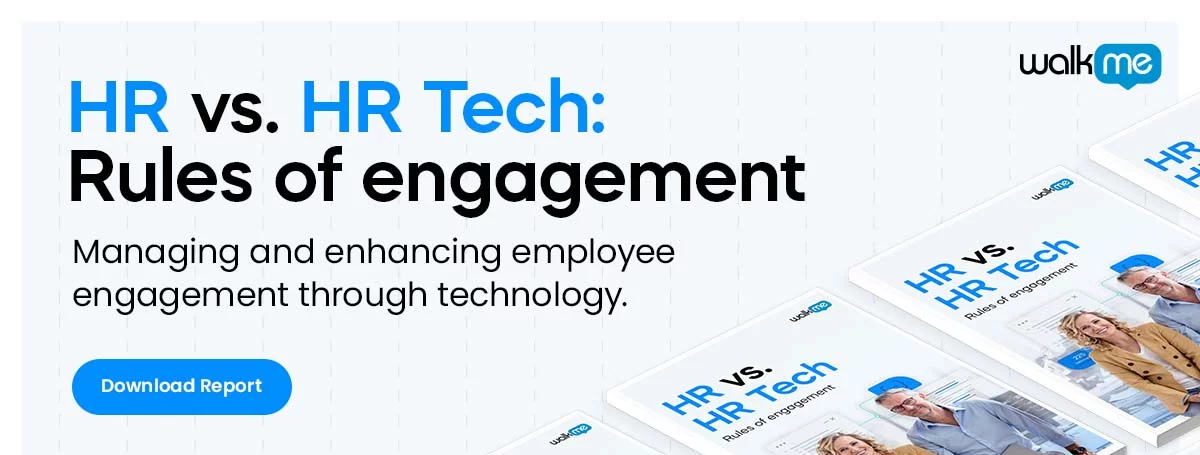
Training and Development are hot topics in 2023. According to Statista research, Global spending on training initiatives continues to rise (after a dip during the pandemic).
This spending in strategic human resources management is a wise investment. The world continues to change unpredictably, putting new demands on every employee. The skills we need for tomorrow are unknown. And with the oncoming global recession, companies can’t solve just their problems with a spree of new hires.
This article will take a look at the big picture. It will consider the meaning of HR training and development and explain some key reasons it’s pivotal today. Before we finish, we’ll think about the downsides of training and how you can avoid upsetting your staff.
Good training programs can bring your company up to date. But staff aren’t always highly motivated. In one motivation index, a 2020 BCG survey suggested only 28% would willingly pursue self-service materials. Get to know today’s HR trends, and you’ll have a better chance of success.
What is HR training and development in 2023?
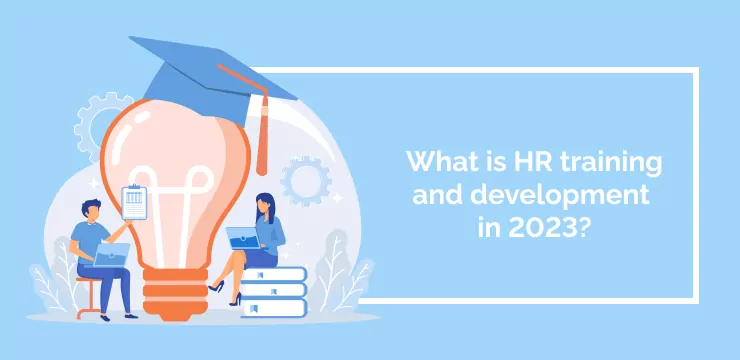
HR training and development refers to activities that help your employees do their jobs better. HR-operated training and development should operate for a specific aim. So, training and development do not have the same “blue sky” thinking of school or university.
Talking about “training and development” in one breath is useful. But they’re not quite the same thing. Training is about getting job-specific skills – in the latest ERP tool, new compliance issues, or project management. Development is a little bit more personal and focused on the individual.
Employees should find training programs accessible, engaging, and appropriate to the context. However, the study of HR training and development is not simple. Experts in HR development will have some knowledge of many disciplines: including psychology, education, communications, organizational development, and adult learning.
The HR department usually takes responsibility for training and development. However, for an effective learning culture, line Managers and CEOs must all be ready to support investment in training.
Training covers all aspects of the skills staff need to complete their jobs. That might include communications techniques, sales, performance management, and customer services. Modern training helps keep businesses updated: maximizing technology, using social media, and understanding diversity and inclusion.
Why should HR training & development be a top priority in 2023?
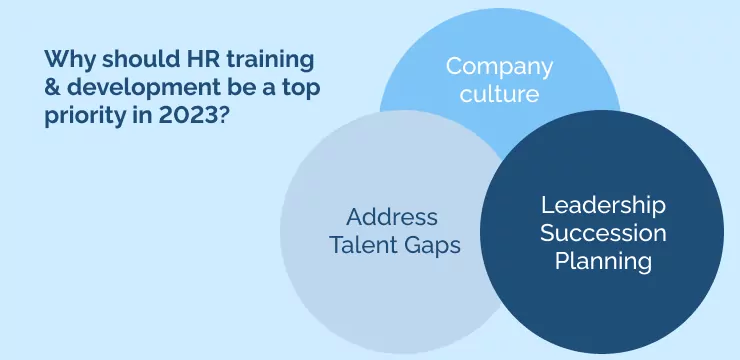
Training and development can reduce turnover, improve business performance, and encourage organizational resilience. In 2023, training and development can also perform more important roles. Training helps to reduce talent gaps, plan for leadership, and enhance a company’s overall culture.
Address Talent Gaps
A key McKinsey survey from 2020 showed that most companies were facing skills gaps or expecting them in the coming years.
Some people choose to solve these problems through new hires. But it’s clear that skill-building can be more effective and efficient. Training programs should begin with a clear skills gap analysis to address talent gaps.
Leadership Succession Planning
A classic HBR article from 2005 explained how good planning improves long-term leadership stability. In companies with good leadership planning, development initiatives were part of the everyday life of the business. People took responsibility for succession planning at every level of the organization: CEOs were aware of the issues, boards were willing to take an active role, and managers found ways to engage their staff.
Company culture
Learning and development are essential components of company culture.
They foster a positive work environment built on trust, engagement, confidence, and shared values. Training programs must be aligned with a company’s mission, values, and goals to be effective. This means carefully considering the topics covered, the methods used, and the availability of training resources.
When employees are willing to participate in training programs, it is a strong indicator of a culture of learning. Through training programs, employees can be led towards higher aspirations, driven by the principles of servant leadership.
Moreover, companies that embrace a learning culture can adapt to changing circumstances and learn from their experiences. By investing in training programs that align with company values, businesses can create a positive work culture that supports employee growth, development, and success.
The factors that influence HR training and development programs in 2023
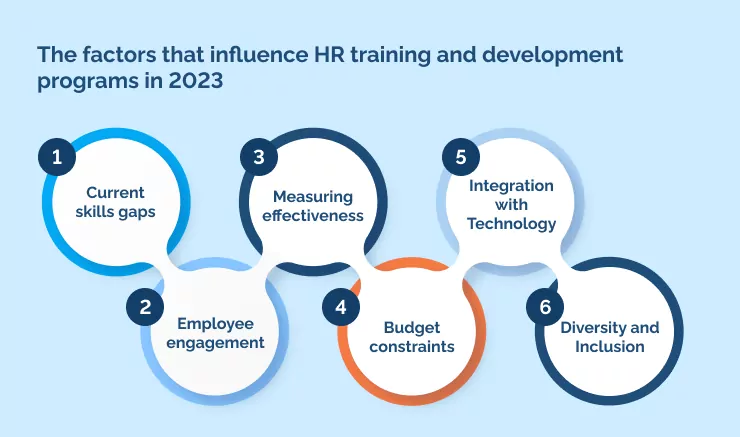
HR Training and development must find a way to balance many issues within and beyond the organization.
Some of the factors that will directly impact training initiatives include:
- Current skills gaps
- Employee engagement
- Measuring effectiveness
- Budget constraints
- Integration with Technology
- Diversity and Inclusion
However, training and development are changing due to various factors. As Kenneth Brown explains, “There is so much we don’t know about the future except this one certainly – it will demand that we adapt to ever-changing social and technical landscapes.” (Cambridge Handbook of Workplace Training, 2018).
Some factors that are currently important include:
- The unpredictable reactions to culture wars
- The material facts of global migration are languages and adapting skills to new circumstances.
- And the importance of diversity and inclusion initiatives
- The quality of national education and apprenticeship programs
- Technology and its applications.
These influences could change rapidly. Overnight, the demands of training could be changed.
How to Evaluate HR Training and Development
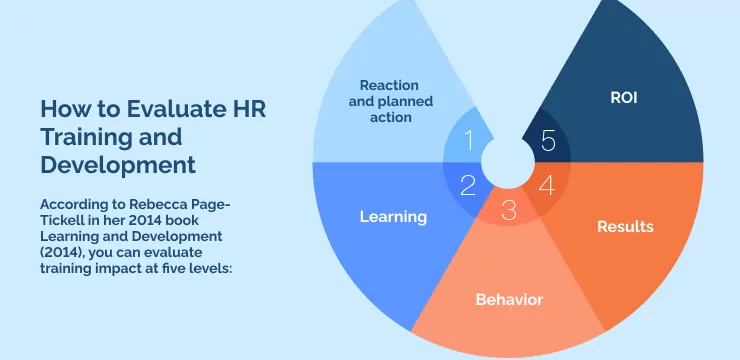
Training and development are a top priority for businesses. But how do you know if employee training has been effective? A good process of evaluation is essential for strategic programs.
Fortunately, researchers have created many different models for understanding this better.
You should start by thinking about different outcomes you can want to produce. That might be a more sophisticated understanding, an improvement in job performance, or an attitude change.
Then you need to consider what impact level you want to measure. In the long term, anyone would wish for an improved ROI from training activities. But it is often difficult to see the connections between training activities and higher revenues.
According to Rebecca Page-Tickell in her 2014 book Learning and Development (2014), you can evaluate training impact at five levels:
- Reaction and planned action: how the staff feels immediately after the training.
- Learning: what staff learn and retain from their training.
- Behavior: how training influences staff actions
- Results: whether changed staff behavior has a positive effect on outcomes
- ROI: whether the results mean a return on the initial investment.
Things could go wrong at any level. Maybe staff love their training, but it doesn’t change how they work. Or, maybe everyone has changed their behavior for the better, but in the end, the results and ROI do not justify the initial input. Training leaders must consider such reports when they are planning ongoing learning activities.
There are several types of training evaluation, as the CIPD explains. Some of the models are:
- The Kirkpatrick model
- Brinkerhoff success case method
- Weinbauer-Heidel’s levers of transfer effectiveness
- Thalheimer’s Learning Transfer Evaluation Model
- Philips’ Return on Investment model
One of these models will help you understand if your company’s training needs are being met.
Why do staff hate training?
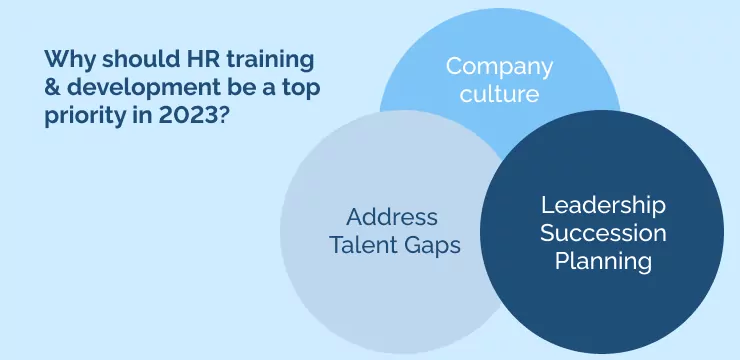
When you listen to enthusiastic HR training professionals, you’ll find development exciting and interesting.
However, staff at many organizations will tell a different story. A BBC magazine article identified some of the problem areas:
- Training is too basic (staff skills have not been assessed)
- Not helpful for day-to-day work (company needs have not been assessed)
- No follow-up after the training
- Too general (training is not personalized enough)
- Too abstract (no application for real-life needs)
- Too tiring (no time for it during the day).
We’ve all been there! And it can be very frustrating to be a staff member for a company that makes these mistakes.
The good news is that modern HR can make a big difference.
There are now some exciting learning and development trends [Link to new article] that support staff where they are. With micro training, in-app experiences, and highly personalized training packages, staff has got excellent access to processes that work.
But at a deeper level, training is best when it is intelligently implemented. A 2023 CIPD podcast emphasized the importance of designing interventions strategically. Start with the impact you want to have and work backward to the solutions. That way, staff can always use their training for good purposes.
HR Training & Development: Creating A Brighter Future
Training can solve many problems. Whether you want to improve employee performance, address a skills gap, or plan for the next generation of leadership, training, and development can help meet your goals. So think carefully about your context, evaluate carefully, and you can aspire to greatness.
Although there’s no doubt about the value of training, we should remember that much money is misspent. A Gartner report from 2020 gives a stark warning: stop training staff in skills they’ll never use. They use only 54% of the skills they are trained in.
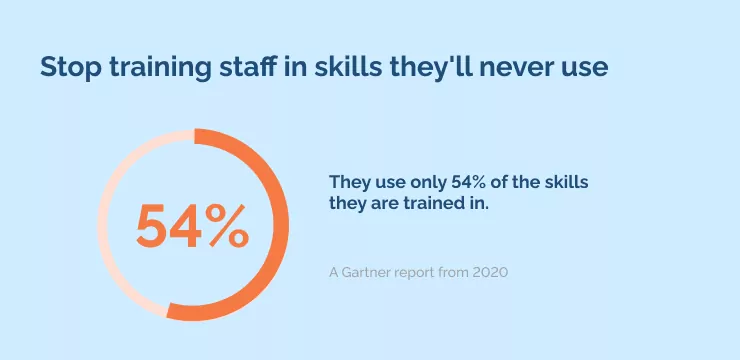
But when you make training relevant and strategic, you can have the highest hopes for your company’s future.
WalkMe Team
WalkMe spearheaded the Digital Adoption Platform (DAP) for associations to use the maximum capacity of their advanced resources. Utilizing man-made consciousness, AI, and context-oriented direction, WalkMe adds a powerful UI layer to raise the computerized proficiency, everything being equal.
